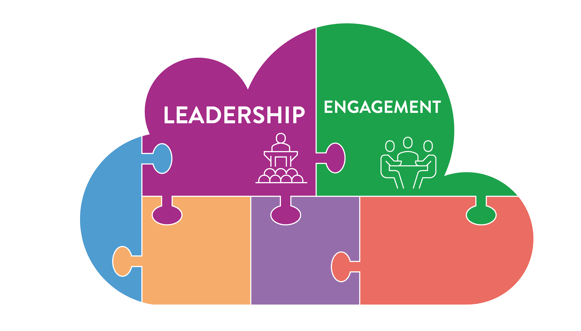Contents
The Missing Piece of the Health and Safety Jigsaw Puzzle Part 2: Engagement
2 June 2020 - Evotix
In our last blog we placed the first piece of the Health and Safety Jigsaw Puzzle that detailed how leadership is the first step in driving a positive culture. Now, we continue onto the next piece of the puzzle…engagement.
Starting a jigsaw puzzle and keeping it in one central place, whether it’s your living room or workplace break room, is an invitation for all to participate whenever anyone has a few minutes (or let’s face it, all night!) to work on it. Puzzles are an excellent way for people to spend time together while working towards a shared goal. This same thought applies to engaging employees in safety.

Why engagement is a group activity
Gallup studied more than 1.8 million global employees and their workplaces to determine how engagement impacted safety. It found that organisations rated in the top 25% for engagement had 70% fewer incidents than those in the bottom 25%.
On top of reduced incidents, engaged employees are more likely to be bought into the success of a business which improves their productivity and drives increased profitability. Rightly, safety becomes a priority for everyone - they want the business to succeed and do not want to see anybody get hurt.
Where to start with piecing together engagement
As discussed in our previous blog, engagement is driven by leadership teams and safety professionals throughout an organisation. Leadership cannot force employees to participate, but they can actively encourage them by setting an example that makes employees want to engage. But how can you take it a step further to get total buy-in?
You can start by:
- Keeping it simple, stupid (KISS): If health and safety isn’t easy to participate with, then people won't do it. Remove manual, antiquated, paper-based processes for managing health and safety to make it easy for employees to be involved and fully participate.
- Closing the Feedback Loop: How often has an employee submitted feedback or a hazard, but not heard anything back? Typically (any input goes into a health and safety black hole. To keep employees actively engaged, it is important to close that feedback loop. Every single employee deserves access to participate, report and consume safety information.
- Providing Organisation-Wide Visibility: The same way we want to share safety performance reporting with leaders, we need to share similar data with employees. By providing that visibility, the entire organisation can see the difference they are making in helping improve health and safety performance.
- Performing Inspections: Employees want to arrive safely to work every day and, more importantly, leave work in the same manner. This is why organisations have a duty of care in ensuring that inspections are regularly taking place and completed on time.
How technology can help keep the pieces in place
Organisations need the right tools and processes to eliminate barriers that would prevent employees from easily participating in health and safety. Put yourself in the shoes of your workforce – how easy is it for them to report an incident, hazard or near-miss? Post-event, do they have to walk to the head office to retrieve a form, fill it out and then walk back to head office? Why not give them an easily accessible way to report safety observations and incidents in real-time?
Utilising safety management software that is easily accessible from the mobile device every one of your employees has in their pocket enables them to just complete audits, inspections, and assessments as part of their daily activities, 24/7, online or offline. Employees can capture health and safety information in any location instead of searching the office for the correct form and a pencil.
Technology helps health and safety professionals close the feedback loop by assigning corrective and preventative actions with visibility to track progress to resolution. A continuously improving business makes it easy for the entire organisation to engage in workplace safety.
Putting the second piece of the puzzle in place
Every piece that goes into the health and safety jigsaw puzzle must fit and build on the previous pieces – if one piece is not in place, then the jigsaw puzzle will be incomplete. Leadership drives engagement, engagement drives data, data drives improvement, and improvement drives leadership. Join us next week as we discuss how collecting and utilising safety data fits into our Health and Safety Jigsaw Puzzle.
In the meantime, why not talk to us about how our health and safety management software solution drives engagement by putting safety in the hands of your workforce.
Want to go back and re-read the first jigsaw piece on leadership? Click here.
RELATED BLOGS

7 Ways Camaraderie Enhances Workplace Health and Safety
29 August 2023 - Evotix
Camaraderie is crucial for cultivating a workplace built on trust and respect between employees, supervisors and managers. Beyond creating a friendly and open environment, promoting camaraderie can..

Safety Check: Identifying When To Revise Your Health and Safety Processes
26 September 2023 - Evotix
Irrespective of your industry, your organization holds the vital responsibility of ensuring the safe return of your employees to their homes each day. When an incident occurs, it falls on you to..

A Farewell to Manual Processes: Why You Should Ditch Them For Health and Safety
18 November 2021 - Evotix
One of the great classics in American literature is A Farewell to Arms by Ernest Hemingway. In the title, “arms” naturally means weapons, but it got us thinking about human arms—the ones attached to..
